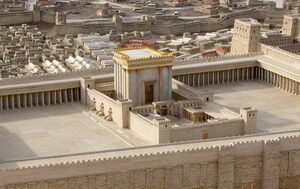إنكار الهيكل

Temple denial is a claim advanced by Palestinian political leaders, religious figures, intellectuals, and authors that the successive Temples in Jerusalem did not exist or were placed other than on the Temple Mount.[1]
Yitzhak Reiter describes the growing tendency of Islamic authorities to deny the existence of the Jewish Temples on the Temple Mount, characterizing it as part of a campaign to increase the status of Jerusalem and the Temple Mount in Islam as part of the effort to make Jerusalem a Muslim city under Arab governance.[1] The New York Times noted that "Temple denial, increasingly common among Palestinian leaders, also has a long history: After Israel became a state in 1948, the Waqf removed from its guidebooks all references to King Solomon's Temple, whose location at the site it had previously said was 'beyond dispute'."[2][3] David Hazony has described the phenomenon as "a campaign of intellectual erasure [by Palestinian leaders, writers, and scholars] ... aimed at undermining the Jewish claim to any part of the land", and compared the phenomenon to Holocaust denial.[4][5]
. . . . . . . . . . . . . . . . . . . . . . . . . . . . . . . . . . . . . . . . . . . . . . . . . . . . . . . . . . . . . . . . . . . . . . . . . . . . . . . . . . . . . . . . . . . . . . . . . . . . . . . . . . . . . . . . . . . . . . . . . . . . . . . . . . . . . . . . . . . . . . . . . . . . . . . . . . . . . . . . . . . . . . . .
Background
The Temple Mount is the holiest site in Judaism.[6][7][8] According to Jewish tradition and scripture, the First Temple was built by King Solomon, the son of King David, in 957 BCE, and was destroyed by the Neo-Babylonian Empire in 586 BCE. The Second Temple was constructed under the auspices of Zerubbabel in 516 BCE, was renovated by King Herod, and was destroyed by the Roman Empire in 70 CE. Scholars today agree that the two temples existed on the Temple Mount during these time periods.[9]
See also
- Antonia Fortress
- Anti-Zionism
- Historicity of the Bible
- Islamization of the Temple Mount
- Ernest L. Martin
- Quds Day
Footnotes
- ^ أ ب خطأ استشهاد: وسم
<ref>غير صحيح؛ لا نص تم توفيره للمراجع المسماة:3 - ^ Rudoren, Jodi (November 22, 2014). "Mistrust Threatens Delicate Balance at a Sacred Site in Jerusalem". The New York Times.
- ^ A Brief Guide to al-Haram al-Sharif, a booklet published in 1925 (and earlier) by the "Supreme Moslem Council", a body established by the British government to administer waqfs and headed by Hajj Amin al-Husayni during the British Mandate period, states on page 4: "The site is one of the oldest in the world. Its sanctity dates from the earliest (perhaps from pre-historic) times. Its identity with the site of Solomon's Temple is beyond dispute. This, too, is the spot, according to universal belief, on which 'David built there an altar unto the Lord, and offered burnt offerings and peace offerings.' (2 Samuel 24:25)"
- ^ Hazony, David. "Temple Denial In the Holy City", The New York Sun, March 7, 2007.
- ^ Gold, pp. 10 ff.
- ^ Rivka, Gonen (2003). Contested Holiness: Jewish, Muslim, and Christian Perspectives on the Temple Mount in Jerusalem. Jersey City, NJ: KTAV Publishing House, Inc. p. 4. ISBN 0-88125-798-2. OCLC 1148595286.
To the Jews the Temple Mount is the holiest place on Earth, the place where God manifested himself to King David and where two Jewish temples - Solomon's Temple and the Second Temple - were located.
- ^ Marshall J., Breger; Ahimeir, Ora (2002). Jerusalem: A City and Its Future. Syracuse University Press. p. 296. ISBN 0-8156-2912-5. OCLC 48940385.
- ^ Cohen-Hattab, Kobi; Bar, Doron (2020-06-15). The Western Wall: The Dispute over Israel's Holiest Jewish Site, 1967–2000 (in الإنجليزية). BRILL. ISBN 978-90-04-43133-1.
- ^ Joshua Hammer. "What is Beneath the Temple Mount?". Smithsonian Institution. Retrieved December 2, 2015.
References
- Gold, Dore (2002). The Fight for Jerusalem: Radical Islam, the West, and the Future of the Holy City. Regnery Publishing. ISBN 1-59698-029-X.
